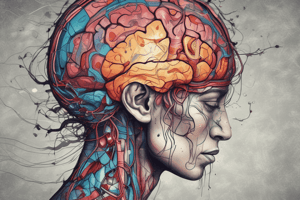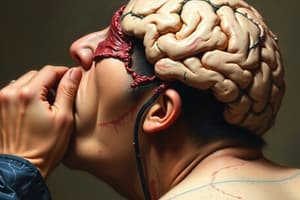Podcast
Questions and Answers
Which of the following best describes a primary traumatic brain injury (TBI)?
Which of the following best describes a primary traumatic brain injury (TBI)?
- Physiologic responses to the initial injury.
- Brain damage resulting from increased intracranial pressure after the initial impact.
- Mechanical damage that occurs at the time of the traumatic event. (correct)
- The development of cerebral edema days after the initial injury.
A patient involved in a motor vehicle accident presents with a basilar skull fracture. Which assessment finding would be most indicative of this type of fracture?
A patient involved in a motor vehicle accident presents with a basilar skull fracture. Which assessment finding would be most indicative of this type of fracture?
- Break in the cranial bone at the base of the skull. (correct)
- Localized bleeding and swelling outside the brain.
- Tearing of nerve fibers in the white matter.
- Localized bleeding and swelling inside the brain.
A patient is diagnosed with a contusion following a fall. What specific type of injury is a contusion?
A patient is diagnosed with a contusion following a fall. What specific type of injury is a contusion?
- Tearing of brain tissue.
- Generalized disruption of neuronal function.
- Localized bleeding and swelling inside the brain. (correct)
- Functional injury without pathological injury.
Which of the following mechanisms primarily contributes to diffuse axonal injury (DAI) in traumatic brain injury?
Which of the following mechanisms primarily contributes to diffuse axonal injury (DAI) in traumatic brain injury?
A patient with a traumatic brain injury is experiencing increased intracranial pressure (ICP). Which secondary injury is most directly related to this condition?
A patient with a traumatic brain injury is experiencing increased intracranial pressure (ICP). Which secondary injury is most directly related to this condition?
Which of the following is the MOST common cause of traumatic brain injury?
Which of the following is the MOST common cause of traumatic brain injury?
A patient presents with a mild traumatic brain injury. Which of the following symptoms is MOST indicative of this condition?
A patient presents with a mild traumatic brain injury. Which of the following symptoms is MOST indicative of this condition?
Which of the following assessments is MOST important when recognizing cues related to neurological function in a patient with a traumatic brain injury?
Which of the following assessments is MOST important when recognizing cues related to neurological function in a patient with a traumatic brain injury?
Which of the following nursing actions is MOST important for a patient with a traumatic brain injury?
Which of the following nursing actions is MOST important for a patient with a traumatic brain injury?
Which of the following therapies is considered a collaborative action in the care of a patient with a traumatic brain injury?
Which of the following therapies is considered a collaborative action in the care of a patient with a traumatic brain injury?
What is the primary purpose of using diuretics in the pharmacotherapy of traumatic brain injury?
What is the primary purpose of using diuretics in the pharmacotherapy of traumatic brain injury?
What is the primary goal of performing a craniotomy on a patient with a traumatic brain injury?
What is the primary goal of performing a craniotomy on a patient with a traumatic brain injury?
What is the difference between a concussion and a contusion?
What is the difference between a concussion and a contusion?
Which TBI is caused by tears or rupture in brain tissue/blood vessels?
Which TBI is caused by tears or rupture in brain tissue/blood vessels?
Which type of skull fracture consists of multiple breaks?
Which type of skull fracture consists of multiple breaks?
Which of the following signs and symptoms is indicative of a moderate to severe TBI?
Which of the following signs and symptoms is indicative of a moderate to severe TBI?
What is the purpose of monitoring Cushing's Triad in TBI patients?
What is the purpose of monitoring Cushing's Triad in TBI patients?
What is the purpose of ventriculoperitoneal shunt surgery?
What is the purpose of ventriculoperitoneal shunt surgery?
Which of the following assessments relates to musculoskeletal function?
Which of the following assessments relates to musculoskeletal function?
Which TBI cause is related to functional deficits without pathological injury?
Which TBI cause is related to functional deficits without pathological injury?
Flashcards
Traumatic Brain Injury (TBI)
Traumatic Brain Injury (TBI)
Injury resulting from an external force causing disruption of normal brain function due to displacement of the brain within the skull.
Primary TBI
Primary TBI
Results from mechanical injury at the time of trauma, such as skull fractures, contusions and diffuse axonal injury.
Secondary TBI
Secondary TBI
Physiologic responses to the initial injury like increased intracranial pressure and hypoxia.
Skull Fracture (Primary TBI)
Skull Fracture (Primary TBI)
Signup and view all the flashcards
Contusion (Primary TBI)
Contusion (Primary TBI)
Signup and view all the flashcards
Concussion (Primary TBI)
Concussion (Primary TBI)
Signup and view all the flashcards
Laceration (Primary TBI)
Laceration (Primary TBI)
Signup and view all the flashcards
Diffuse Axonal Injury (Primary TBI)
Diffuse Axonal Injury (Primary TBI)
Signup and view all the flashcards
Ischemia (Secondary TBI)
Ischemia (Secondary TBI)
Signup and view all the flashcards
Hypoxia (Secondary TBI)
Hypoxia (Secondary TBI)
Signup and view all the flashcards
Cerebral Edema (Secondary TBI)
Cerebral Edema (Secondary TBI)
Signup and view all the flashcards
Increased Intracranial Pressure (IICP) (Secondary TBI)
Increased Intracranial Pressure (IICP) (Secondary TBI)
Signup and view all the flashcards
Meningitis (Secondary TBI)
Meningitis (Secondary TBI)
Signup and view all the flashcards
Epilepsy (Secondary TBI)
Epilepsy (Secondary TBI)
Signup and view all the flashcards
Mild TBI Symptoms
Mild TBI Symptoms
Signup and view all the flashcards
Moderate to Severe TBI Symptoms
Moderate to Severe TBI Symptoms
Signup and view all the flashcards
Musculoskeletal Assessment (TBI)
Musculoskeletal Assessment (TBI)
Signup and view all the flashcards
Physical Therapy
Physical Therapy
Signup and view all the flashcards
Occupational Therapy
Occupational Therapy
Signup and view all the flashcards
Common causes of TBI
Common causes of TBI
Signup and view all the flashcards
Study Notes
- Traumatic Brain Injury (TBI) results from an external force
Overview
- TBI disrupts normal brain function due to brain displacement within the skull
- Primary TBI results from mechanical injury at time of trauma
- Secondary TBI involves physiologic responses to the initial injury which can take seconds, minutes or days to appear
Primary TBI
- Occurs immediately at time of trauma
- Include skull fractures, contusions, concussions, lacerations, diffuse axonal injury, and intracranial hemorrhage
- Caused by penetrating or non-penetrating injuries
Primary TBI: Skull Fracture
- Break in the cranial bone
- Types include linear, comminuted, depressed, and basilar fractures
Primary TBI: Contusion
- Structural injury involving localized bleeding and swelling inside the brain
- Caused by blunt trauma or coup-contrecoup injuries
Primary TBI: Concussion
- Functional injury resulting in functional deficits without pathological injury
- Caused by a sudden blow or rapid movement of the head through low velocity forces
Primary TBI: Laceration
- Tearing or rupture in brain tissue or blood vessels
- Pia and arachnoid layers are pierced
- Caused by blunt or penetrating trauma
Primary TBI: Diffuse Axonal Injury
- Traumatic shearing forces lead to tearing of nerve fibers in the white matter
- Caused by rapid acceleration, deceleration, or rotational forces
- Leading cause of long-term disability and trauma
Secondary TBI
- Delayed from primary injury
- Examples include Ischemia, hypoxia, hypotension/HTN, cerebral edema, increased intracranial pressure (IICP), hypercapnia, meningitis, epilepsy, and biochemical changes
Recognize Cues: Mild TBI
- Presents with headache, memory problems, blurred vision, dizziness and fatigue, and sleeping difficulties
Recognize Cues: Moderate to Severe TBI
- Presents with persistent headache, profound confusion, slurred speech, seizure, and coma
Neurological Cues
- Assess mental status
- Check pupillary response and Glasgow Coma Scale
- Assess sensory function like facial movements, light touch, pain, stereognosis, and graphesthesia
Musculoskeletal Cues
- Assess motor function through inspection/palpation
- Measure limb size
- Evaluate range of motion, muscle strength, gait, coordination/balance, and reflexes
Nursing Actions
- Establish baseline, secure airway/breathing and monitor ABG's
- Monitor vital signs, maintain cerebral perfusion pressure (CPP) and monitor for Cushing's Triad
- Positioning of patient to promote perfusion
- Implement neurologic examinations, check cranial nerves, Glasgow Coma Scale and monitor posturing
Collaborative Actions
- Physical Therapy
- Occupational Therapy
- Speech and Language Therapy
- Cognitive Rehabilitation
- Psychological Support
Pharmacotherapy
- Anticonvulsants
- Barbiturates
- Calcium Channel Blockers
- Diuretics
Surgical Interventions
- Craniotomy
- Craniectomy followed by cranioplasty
- Endoscopic Ventriculostomy
- Ventriculoperitoneal Shunt Surgery
Traumatic Brain Injury Statistics
- Leading causes include
- Falls (28%)
- Motor vehicle accidents (20%)
- Struck by objects (19%)
- Assault (11%)
- Suicide (1%)
Studying That Suits You
Use AI to generate personalized quizzes and flashcards to suit your learning preferences.




